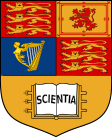This article's use of external links may not follow Wikipedia's policies or guidelines.(March 2025) |
 Dyson Building on Imperial College Road | |
| Established | 2014 [1] |
|---|---|
Head of School | Professor Robert Shorten [2] |
| Faculty | Imperial College Faculty of Engineering |
| Staff | 56 [3] |
| Students | 409 [3] |
| Location | Exhibition Road, London, United Kingdom 51°29′53″N0°10′28″W / 51.497975°N 0.174382°W |
| Campus | South Kensington |
| Website | www |
| Map | |
The Dyson School of Design Engineering is the academic centre for design engineering at Imperial College London. The school has just over 50 academic staff and 400 students, with over 220 undergraduates. [3] The school is located in the Dyson building, at the corner of Exhibition and Imperial College roads.

